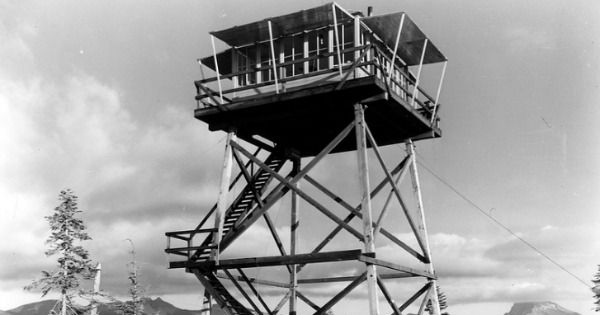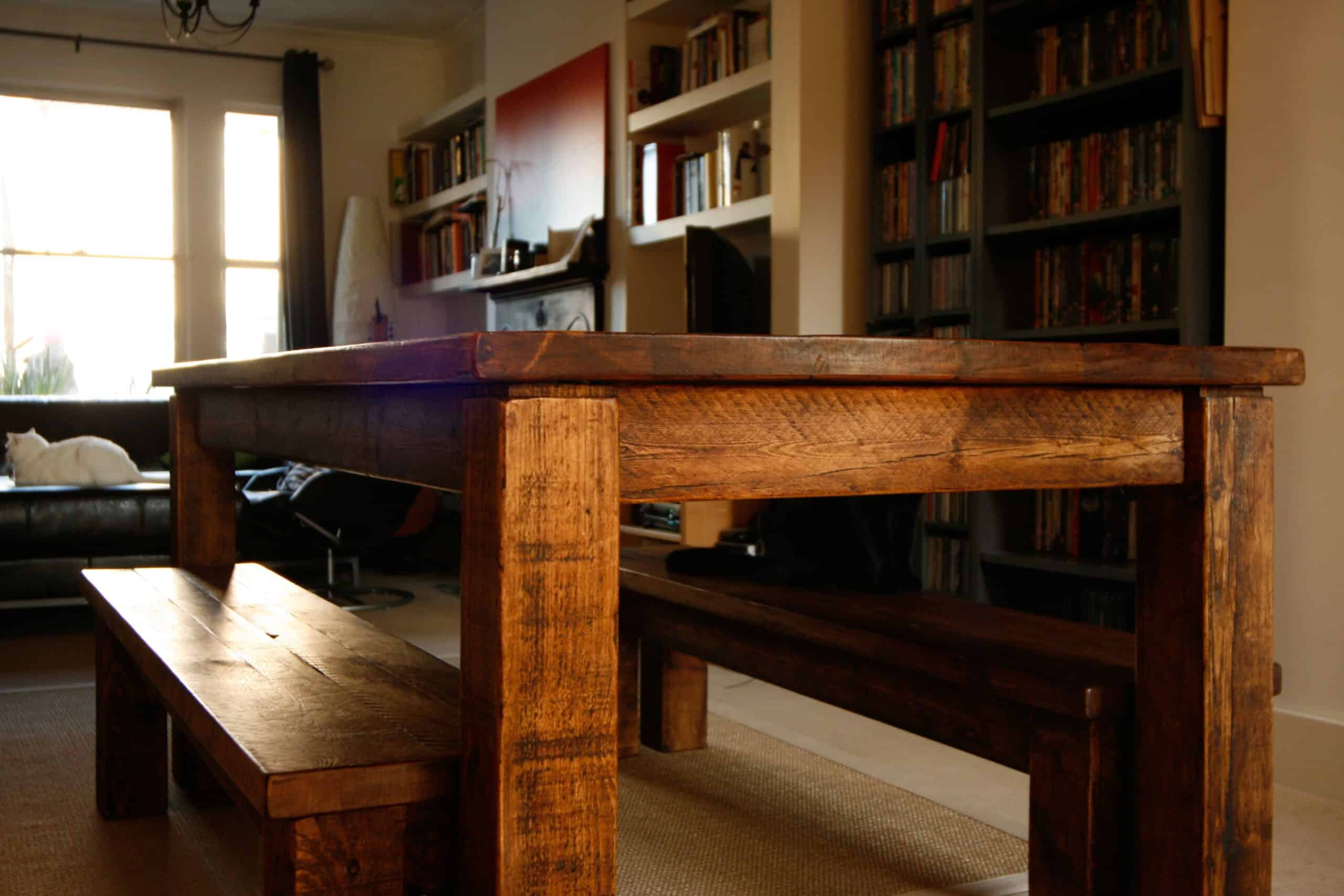(Photo: Forest Service/flickr)
Smokey the Bear wasn’t born in a cave, you know. He was born on Madison Avenue in 1944 to the same parents as the Crash Test Dummies, McGruff the Crime Dog and the Crying Indian.
There is, however, a good chance that the real Smokey — the orphaned black bear that served as the living symbol of the Ad Council’s beloved forest fire prevention mascot from 1950 to 1976 — was born in a cave.
The real Smokey wouldn’t have had a chance to capture the hearts of an entire nation if a fire tower operator — the paid “lookout” perched high above Lincoln National Forest in New Mexico’s Capitan Mountains — had failed to spot smoke and signal for help in the spring of 1950. Separated from his mother, the frightened and singed 3-month-old cub — first known as Hotfoot Teddy and then Smokey Bear — was rescued from a tree during the massive blaze by fire crews and then nursed back to health at the National Zoo. The rest is history.
(Photo: Forest Service/flickr)
Fire lookout towers still stand vigilant today, not just across New Mexico but the entire United States.
According to the Former Fire Lookout Sites Register, lookout towers once numbered as many as 8,000, and could be found across every state save for Kansas.
Today, it’s estimated there are fewer than 2,000 lookout towers left. A majority can be found in the vast, mountainous forests of Oregon, Montana, California, Washington and Idaho.
Thanks to a number of grassroots historic preservation efforts, that figure is no longer shrinking as fast as it was during the 1970s and ’80s when advances in forest fire detection, particularly radio and satellite technology, made paying someone to stand watch in a sky-high cabin obsolete.
Lincoln National Forest alone was once home to 16 fire lookout towers — nine still remain, six of them listed on the National Register of Historic Places including Monjeau Lookout, a distinctive stone tower in the Smokey Bear Ranger District that dates to 1936. (That’s it pictured above.)
Sadly, the Block Lookout, the tower that the Capitan Gap Fire of 1950 first was spotted from, was demolished years ago.
(Photo: Forest Service/flickr)
Lookouts: A lonely but honorable job
Like many lookout towers still standing in federally protected forests, the fire towers of Lincoln National Forest were built during the early and mid-1930s — the height of the Great Depression — by members of the Civilian Conservation Corps, President Franklin D. Roosevelt’s New Deal work relief program for young, unemployed men and World War I veterans. Alongside roads, trails, bridges and park facilities, the Conservation Corps built hundreds upon hundreds of fire towers during this period.
(Photo: Forest Service)
The building of these far-flung fire towers didn’t just generate construction jobs. From the 1930s onward, the U.S. Forest Service enlisted hundreds of trained fire tower operators, many of them women. Acting as a tower-bound sentinel deep in a forest or atop a mountain was a lonely and thankless task, but these paid lookouts took pride in their work — particularly during the heyday of Smokey Bear when forest fire prevention was, well, trendy.
Aside from strong eyesight and a hardy constitution, lookouts were skilled at using Osborne Fire Finders, a type of alidade table that enabled lookouts to determine the directional bearing of a potential blaze before alerting fire crews. These curious-looking circular map-tables can still be found in numerous historic fire towers.
(Photo: Mike Haeg/flickr)
From 1941 through 1944, fire tower operators, particularly those on the West Coast, pulled double-duty as Enemy Aircraft Spotters.
Given their solitary existence, many, naturally went on to become noted published authors including essayist Philip Connors, poets Philip Whalen and Gary Snyder and Norman Maclean, the author of “A River Runs Through It and Other Stories.”
Most famously, Beat Generation superstar Jack Kerouac signed up for a three-month stint during the summer of 1956 as a fire lookout at Desolation Peak in Washington’s North Cascades, writing about his booze-aided sojourn at length in a handful of published works including «The Dharma Bums» (1958), “Lonesome Traveler” (1960) and “Desolation Angels” (1965).
(Photo: Forest Service/flickr)
From coast to coast, cabins in the sky
Fire lookout towers and the dedicated men and women who populated them for weeks — even months at a time — existed, of course, long before the advent of the Civilian Conservation Corps. Numerous fire towers — some still standing — even predate the creation of the Forest Service in 1905. These early examples were built and operated by lumber companies, private landowners, townships and state forestry organizations.
(Photo: TheTurducken/flickr)
However, it was during the aftermath of the Great Fire of 1910, a record-breaking blaze that swept across Idaho, Montana and Washington, that Forest Service-sanctioned fire towers began popping up in earnest.
While the Great Fire of 1910 was limited to the Northwest, the flurry of fire lookout towers built during the 1910s wasn’t exclusive to that region. In fact, some of the best-known fire towers from this era were built on the East Coast, including the historic lookouts found in New York’s Catskill Park and Adirondack Forest Preserve. Some New York lookouts are even older, including the Balsam Lake Mountain Fire Observation Station, which was first erected in 1897 and is believed to be the oldest fire lookout in the Empire State. (The current structure, built in 1930, is pictured above). Regularly manned until 1988, the tower was slated for demolition until a group of activists stepped in to save it. It’s been open to hikers since 2000.
(Photo: Tony Webster/flickr)
Other historic fire lookout towers of note include Boucher Hill Lookout in Palomar Mountain State Park, San Diego County; Fairview Peak Lookout, a simple stone structure in Colorado’s Gunnison National Forest that, at a dizzying elevation of 13,2000 feet, is the highest lookout in North America; and the Woodworth Fire Tower, a 175-foot-tall structure in central Louisiana’s Alexander State Forest that’s believed to be the tallest fire tower in the world.
Considered as a «first step» to inclusion on the National Register of Historic Places is recognition by the National Historic Lookout Register (NHLR), a joint effort between the Forest Service, the Forest Fire Lookout Association and various state agencies. The NHLR lists registered lookout towers, state by state, with new additions added frequently. Idaho (111), California (122) and Oregon (128) are the only three to crack the double digits. Alabama, Arizona, Montana and Washington all have a decent number of historic fire lookouts while Alaska, Hawaii and Kansas have none.
(Photo: Forest Service/flickr)
Your private forest retreat awaits … (don’t forget toilet paper)
A large number of fire tower lookouts that were retired from active service have been restored and reborn as available-for-rent overnight lodgings depending on the season, weather conditions and availability. Most of them are 1930s- to 1950s-era structures built by the Civilian Conservation Corps throughout the expansive national forests of the West; all are listed through Recreation.gov, the booking and trip-planning portal shared by 12 different federal agencies including the Forest Service, the National Park Service and the Bureau of Land Management.
(Photo: Forest Service/flickr)
Although largely located in California, Oregon, Montana, Washington and Idaho, for-rent fire lookouts — think of them as cabin-treehouse hybrids — can also be found in Colorado, Wyoming and beyond. Two historic fire lookouts in New Mexico’s Lincoln National Forest, birthplace of Smokey Bear, are even expected to be converted into rustic crash pads in the future.
That said, the rental lookouts listed on Recreation.gov aren’t geared for glampers. They come equipped with cots and basic furnishings but most lack running water and electricity. In some cases, an arduous hike through steep terrain and then up a steep flights of stairs is required to access them. It’s roughing it. Bun then again, lookouts have never been known for providing cushy amenities. It’s all about the proximity to an array of recreational activities, the tranquil isolation and the panoramic views that are well worth the $40-ish/night rental fee. It’s not about what’s inside, but what’s outside.
Sound appealing? Check out these seven National Forest Service-maintained fire lookouts available for rent …
Arid Peak Lookout – Idaho Panhandle National Forests
(Photo: Alexandra M/flickr)
From Bald Mountain to Shorty Peak, Idaho is home to a handful of rentable lookout gems. A popular option — for those who don’t mind lugging in and out supplies along a vertiginous 3-mile trail — is Arid Peak Lookout. Built in 1934, the tower (elevation: 5,306 feet) was in active use until 1969. After sitting abandoned for decades, it was restored by a team of volunteers in 1997.
Like other for-rent lookouts, the list of provided amenities at Arid Leak may be brief (cots, cooking pots, propane camp stove), but the list of nearby recreational activities is abundant. In addition to hiking trails and trout streams that run through the St. Joe River area of the Idaho Panhandle National Forests, the Hiawatha Bicycle Trail is a top draw. This popular rail-to-trail bike path winds 15 miles through the Bitterroot Mountains along the tunnel- and trestle-heavy route of the old Milwaukee Road. Coincidentally, this area was decimated by a massive forest fire, the largest in American history, in 1910. Claiming 87 lives and 3 million acres of forest across Idaho, Washington and Montana, the Great Fire of 1910 is why, a century later, so many historic fire lookouts in the inland Pacific Northwest exist.
Bald Knob Lookout – Rogue River-Siskiyou National Forest, Oregon
(Photo: Forest Service/flickr)
Rather rude name aside, Bald Knob Lookout (elevation: 3,630 feet) is the perfect crash pad after exploring the ultra-scenic hiking trails that snake through Oregon’s Wild Rogue wilderness area. Perfect if you’re OK with primitive vault toilets and no electricity.
Dating to 1931, the original fire lookout — used as an Aircraft Warning station during World War II — was replaced with a flat-roof structure in the early 1960s. In more recent years, the lookout has provided adventurous types with pack it in/pack it out-style accommodations. Measuring 16 feet-by-16-feet and perched atop a 21-foot tower, the cabin can accommodate up to four but has only one single bed … nothing like drawing straws by the light of a propane lamp to see who doesn’t have to sleep on the floor. Particularly popular with birders and waterfall lovers, the lookout is open for reservations from Memorial Day through mid-October.
(Photo: USFS Region 5/flickr)
Calpine Lookout — Tahoe National Forest, California
Just as in-demand in the winter as it is during the summer, Calpine Lookout is perched nearly 6,000 feet above California’s Sierra Nevada. Built in 1934 and active as a fire tower for decades, the three-story wooden structure is one of only three once-bountiful windmill-style lookout towers remaining in California. It’s been available as a rental since 2005.
To be clear, only the top floor — the observation cab — of the historic tower is available for overnights. (Back in the day, the ground floor was used for storage and the second floor served as sleeping quarters for resident fire-spotters.) And like with other fire lookouts for-hire, guests must arrive with their own water, firewood, bedding, toilet paper and the like. (The toilet, by the way, is of the pit variety). As Bonnie Tsui wrote for the New York Times in 2009, Calpine Lookout’s appeal extends far beyond serving as base camp for skiers in the winter and hikers in the summer: “[I]t’s also a gorgeous place to do pretty much nothing, other than read by day and stargaze by night, or watch the sun’s progress play upon the high-altitude mountain landscape.”
Clearwater Lookout Cabin — Umatilla National Forest, Washington
(Photo: Forest Service/flickr)
Perched at an elevation of 5,600 feet in the rugged — and fungi-famous — Blue Mountains of northeastern Oregon and southeastern Washington state, the Clearwater Lookout Cabin offers something of a compromise for those who like the idea of hunkering down for the night in a fire lookout tower but, in reality, would rather sleep closer to the ground. Constructed in 1935, this rustic wood-frame cabin is located at the base of a 94-foot-tall lookout tower erected in 1933 by the Civil Conservation Corps that, while no longer in regular use, is still used by the Forest Service in the event of extreme fire conditions.
Open year-round but only accessible during the winter by snowmobile or cross country skis, amenities at the secluded shanty are typically no-frills: propane heat, no running water and not a single linen in sight. In addition to water, sleeping bags and a whole mess of bug spray, a packing list must-have is a pair of decent binoculars for better marveling at the unblemished, star-filled night sky.
Gold Butte Lookout — Willamette National Forest, Oregon
(Photo: Forest Service/flickr)
When a rental’s official list of amenities includes a broom, a chair and a fire extinguisher but not water or electricity, it should be obvious that it isn’t the kind of place to putter around indoors. And indeed Gold Butte Lookout, with its knock-out panoramic views of the Cascade Range, serves as the ideal crash pad for spending quality time — hiking, birding, canoeing, stargazing, berry picking, you name it — amid some of Mother Nature’s finest handiwork.
At an elevation of 4,618 feet, the lookout was constructed in 1934 by the Civilian Conservation Corps. During World War II, it served as an Aircraft Warning System station, manned 24/7 by an eagle-eyed husband-wife team. No longer used to spot forest fires or enemy aircraft, the stilted wood-frame structure is open to guests from July through mid-October. That said, the lookout won’t be available for sleepovers during August’s total solar eclipse due to public safety concerns over dramatic increases in traffic within Willamette National Forest. However, the area around the lookout — sporting a beefed-up Forest Service presence — will remain accessible.
Monument Peak Lookout — Lewis & Clark National Forest, Montana
(Photo: Forest Service Northern Region/flickr)
After sitting abandoned for decades, Monument Peak Lookout was carefully severed from its 50-foot tower and moved to a less dizzying foundation for restoration work in 1999. Still, the panoramic views of central Montana’s Little Belt Mountains afforded from this rustic 1930s-era cabin — elevation: 7,395 feet — are spectacular.
Equipped with two beds, a propane stove and some cooking gear, the usual lookout rental conditions apply to this one-room crash pad: no electricity, water or plumbing; winter access is limited to snowmobiles and cross country skis. The Recreation.gov listing also mentions a few unique “know before you go” tidbits: hardhats are recommended when attempting to open the cabin’s heavy window shutters, and visitors can should be prepared to sweep up dead flies upon arrival. A broom, presumably, is provided.
Webb Mountain Lookout — Koontenai National Forest, Montana
(Photo: Forest Service/flickr)
Constructed in 1959 — well after the Pacific Northwest fire tower building boom of the early 1930s — Webb Mountain Lookout looks a bit different than its predecessors. Most notably, in lieu of a wooden tower, the lookout rests atop a tall concrete basement-pedestal. Relative modernity, however, doesn’t mean the tower, perched atop Webb Mountain in Montana’s Koocanusa wilderness area, is deluxe. It’s the same small, sparsely furnished arrangement as other lookout tower rentals.
Opened seasonally and big enough to sleep five, the tower’s biggest draw is its close proximity to Lake Koocanusa, a 90-mile long outdoor reservoir and recreation hotspot — swimming, sailing, trout fishing, houseboat-ing — created in 1972 by damming the Kootenay River with the Libby Dam. Stretching from the Continental Divide in Montana to the Olympic Peninsula’s Cape Alava, the 1,200-mile Pacific Northwest National Scenic Trail also passes near the lookout.
Inset photos:
Monjeau Fire Tower, New Mexico: Wikimedia Commons; Fire lookout Janice Mackey, 1956: Forest Service/flickr; Balsam Lake Mountain Fire Observation Station: TheTurducken/flickr; Clear Lake Lookout, Mt. Hood/Snowmobilers: Forest Service/flickr; Calpine Lookout: USFS Region 5/flickr




